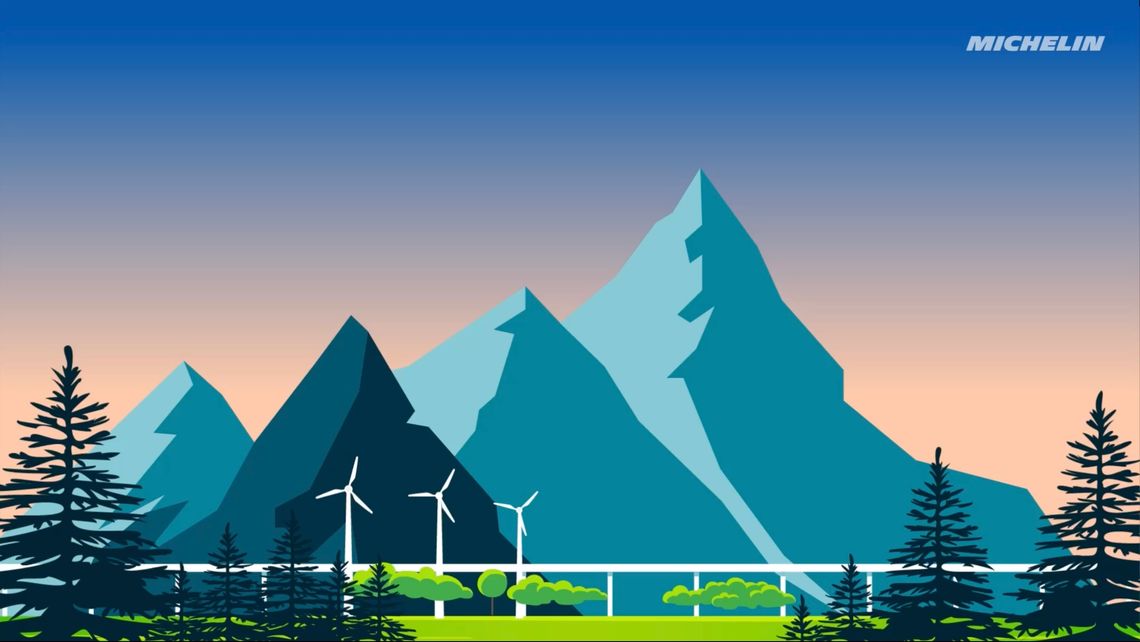Decarbonization: a major strategic issue for Michelin
Michelin has been striving to shrink its carbon footprint for over 30 years. But in the face of the climate emergency, Michelin wants to go a step further with an ambitious decarbonization plan for 2030 and a “net-zero emissions” target for 2050 that are part of the Group’s “All Sustainable” vision.
The successive industrial revolutions, economic and demographic growth, and the globalization of the economy have accelerated climate warming. What can we do? Any industrial undertaking will necessarily have an impact on the environment because it needs raw materials and energy to produce, process, transport and sell. The challenge consists, among other things, in reducing our carbon footprint. This means decarbonizing our direct and indirect activities to put the brake on climate warming, without giving up on the idea of producing goods and services that are essential for human progress.
Michelin: environmental trailblazer
Michelin was far sighted when it brought out its first “green” tire with greater energy efficiency in 1992. Adding silica to the rubber compound lowers rolling resistance, thereby reducing fuel consumption and therefore CO2 emissions. Moreover, in 2002, well before most multinational companies, Michelin published its Performance and Responsibility Charter, of which one of the five fundamental principles is respect for the environment.
In 2021, based on its values and convictions, Michelin adopted a strategy to combat climate change, with the firm intention of remaining within a 1.5°C temperature increase, aligned with the Race to Zero campaign, in a completely transparent manner and without carbon offsetting. This commitment is part of the Michelin Group’s “All-Sustainable” approach, which is underpinned by the balance between People - Profit - Planet.
Environmental protection is one of the three prongs of this approach and Michelin aims to achieve “net-zero emissions” by 2050. This entails reducing the CO2 emissions generated by its own operations and those of its value chain by 90%, and, in the longer term, preparing for the capture and permanent storage of a volume of CO2 equivalent to the annual residual emissions.
This objective accordingly rests on an ambitious decarbonization plan through to 2030, aimed at lowering carbon dioxide emissions from all of its production facilities, logistics operations and supply chain, designing more energy-efficient tires and developing low-carbon mobility through the hydrogen sector... It will complement a policy of protecting resources by incorporating ever-increasing quantities of renewable and recycled materials[1] in its tires. There are various ways of tackling this.
Renewable materials are those obtained from natural resources that can be replenished over a short period of time, on a human scale, such as biomass. This necessarily excludes fossil resources (oil, natural gas, coal, etc.) and minerals (according to the American Chemical Society - "12 Principles of Green Chemistry"). Recycled materials are those generated by any recovery operation that transforms industrial or post-consumer waste into products, materials or substances. This excludes energy recovery and reprocessed materials used as energy (according to the definition by the EU Waste Framework Directive).
Clear objectives
Scope 1 comprises greenhouse gas emissions (GHG) emitted directly by the company (such as the use of fossil fuels for its industrial processes, heating, etc.). Scope 2 measures indirect GHG emissions stemming from the energy purchased and used by the company. Scope 3 covers all the other indirect emissions, such as purchases of raw materials or services, as well as the use of the products and services sold. Scope 3 is not under the company’s direct responsibility, but it is the most comprehensive category and the one with the greatest impact on the environment.
Michelin has carried out a thorough analysis of the tire life cycle, spanning from the extraction of raw materials to the processing of end-of-life tires. It has also set CO2 reduction targets for each stage, such as about 30% reduction in tonnes of CO2 for upstream energy, logistics operations by comparison with 2019, and a 10% increase by 2030 of tires’ energy efficiency during usage versus 2020.
What concrete solutions?
Since 2008, the Michelin Group has been taking steps to develop renewable energies.
In 2023, Group plants in 13 European Union countries, Asia and Brazil have been using guaranteed-renewable electricity. Energy efficiency is still the priority of the “net-zero emissions” roadmap.
In 2023, 361 projects were undertaken, requiring an investment of 114 million euros.
In 2023, 361 projects were undertaken, requiring an investment of 114 million euros.
And what about Scope 3?
The transport, supply chain, and the suppliers of raw materials are also targets for improvement in Michelin’s bid to achieve “net-zero emissions”. Transporting less, better, and differently by using multimodal and decarbonized transportation is a major challenge. Michelin is on track with its roadmap. It reduced shipping-related CO2 emissions by 25% between 2019 and 2023. It is even offering tangible solutions such as the Wisamo inflatable wing, which will make it possible to decarbonize sea freight. On the suppliers’ side, their process for integration, commitment and tracking has already been drawn up for 2024: 70% of their CO2 emissions corresponding to Group purchases will have to be covered by scientific targets. By 2030, Michelin is aiming to reduce the emissions linked to its raw materials purchases by almost 30% compared with 2019. For the disposal of its end-of-life tires, Michelin had engaged technical partners to recycle and reuse certain raw materials (carbon black and steel).
De car bo nize
Four syllables to fight global warming. Michelin has embarked on a vast program to achieve its “net-zero emissions” targets and uphold its “All Sustainable” approach through to 2050. The Group’s decarbonization plan is unfolding for everyone to see and in the firm belief that we can win this race against the clock to protect the climate. At the same time, Michelin is pursuing its commitment through a genuine effort to reduce its environmental footprint: it is protecting biodiversity at its facilities, saving resources and maintaining a responsible natural rubber industry.

